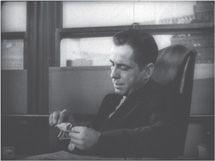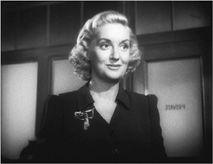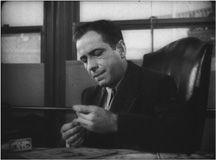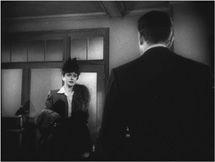B0041VYHGW EBOK (100 page)
Authors: David Bordwell,Kristin Thompson


6.53
The Maltese Falcon:
shot 1b.

6.54
The Maltese Falcon:
shot 2.
Once laid out for us in the first two shots, the space is analyzed into its components. Shots 3
(
6.55
)
and 4
(
6.56
)
show Effie and Spade talking. Because the 180° line established at the outset is adhered to (each shot presents the two from the same side), we know their location and spatial relationships. In cutting together medium shots of the two, however, Huston relies on two other common tactics within the 180° system.

6.55
The Maltese Falcon:
shot 3.

6.56
The Maltese Falcon:
shot 4.
CONNECT TO THE BLOG
For thoughts on the importance of eyeline directions in a very different art form, see “The eyeline match goes way, way back.”
The first is the
shot/reverse-shot
pattern. Once the 180° line has been established, we can show first one end point of the line, then the other. Here we cut back and forth from Effie to Spade. A reverse shot is not literally the reverse of the first framing. It’s simply a shot of the opposite end of the axis of action, usually showing a three-quarters view of the subject. In our bird’s-eye view diagram (
6.50
), shots 2 and 3 form a shot/reverse-shot pattern, as
6.55
and
6.56
do here. Earlier examples in this chapter of shot/reverse-shot cutting are
6.17
,
6.18
and
6.19
,
6.20
.
The second tactic Huston uses here is the
eyeline match
. That is, shot A presents someone looking at something offscreen; shot B shows us what is being looked at. In neither shot are
both
looker and object present. In the
Maltese Falcon
opening, the cut from the shot of Effie (shot 3,
6.55
) to the shot of Spade at his desk (shot 4,
6.56
) is an eyeline match. The shots from
The Birds
of Melanie watching the bird attack and fire also create eyeline matches, as do the examples of editing balancing frame compositions (
6.17
,
6.18
and
6.19
,
6.20
).
Note that shot/reverse-shot editing need not employ eyeline matches. You could film both ends of the axis in a shot/reverse-shot pattern without showing the characters looking at each other. (In
6.56
, Spade is not looking at Effie.) On the whole, however, most shot/reverse-shot cuts also utilize the eyeline match.
The eyeline match is a simple idea but a powerful one, since the
directional
quality of the eyeline creates a strong spatial continuity. To be looked at, an object must be near the looker. The eyeline match presumably created the effects Kuleshov identified in his construction of false spaces through editing. That is, the expressionless actor seems to be looking at whatever we see in the next shot, and the audience assumes that the actor is reacting accordingly.
Within the 180° system, the eyeline match, like constant screen direction, can stabilize space. Note how in shot 3, Effie’s glance off right reiterates Spade’s position even though he is not onscreen. And though Spade does not look up after the cut to shot 4, the camera position remains adamantly on the same side of the axis of action (indeed, the position is virtually identical to that in shot 1b). We know that Effie is offscreen left. Thus the breakdown of the scene’s space is completely consistent. Thanks to the shot/reverse-shot pattern and the eyeline match, we understand the characters’ locations even when they aren’t in the same frame.
The spatial consistency is reaffirmed in shot 5, which presents the same framing as did shot 2. The office is shown again (shot 5a,
6.57
), when the new character, Brigid O’Shaughnessy, enters. Spade stands to greet her, and the camera reframes his movement by a slight tilt upward (shot 5b,
6.58
). Shot 5 is a
reestablishing shot
, since it reestablishes the overall space that was analyzed into shots 3 and 4. The pattern, then, has been
establishment/breakdown/reestablishment
—one of the most common patterns of spatial editing in the classical continuity style.

6.57
The Maltese Falcon:
shot 5a.

6.58
The Maltese Falcon:
shot 5b.
Let’s pause to examine how this pattern has functioned to advance the narrative. Shot 1 has suggested the locale and, more important, has emphasized the protagonist by linking him to the sign on the window. Offscreen sound and Spade’s “Yes, sweetheart?” motivate the cut to shot 2. This establishing shot firmly anchors shot 1 spatially. It also introduces the source of the offscreen sound—the new character, Effie. The shot changes at precisely the moment when Effie enters. We are thus unlikely to notice the cut, because our expectations lead us to want to see what happens next. The area near the door has been shown when the cause–effect chain makes it important, not before.
Shots 3 and 4 present the conversation between Spade and Effie, and the shot/reverse shot and the eyeline match reassure us as to the characters’ locations. We may not even notice the cutting, since the style works to emphasize the dramatic flow of the scene—what Effie says and how Spade reacts. In shot 5, the overall view of the office is presented again, precisely at the moment when a new character enters the scene, and this in turn situates her firmly in the space. Thus narrative elements—the dialogue, the entrance of new characters—are emphasized by adhering to the 180° system. The editing subordinates space to action.
We can trace the same procedures, with one additional variation, in the shots that follow. In shot 5, Brigid O’Shaughnessy enters Spade’s office. Shot 6 presents a reverse angle on the two of them as she comes toward him (shot 6a,
6.59
). She sits down alongside his desk (shot 6b,
6.60
). Up to this point, the 180° line has run between Spade and the doorway. Now the axis of action runs from Spade to the client’s chair by his desk. Once established, this new line will not be violated.

6.59
The Maltese Falcon:
shot 6a.

6.60
The Maltese Falcon:
shot 6b.
